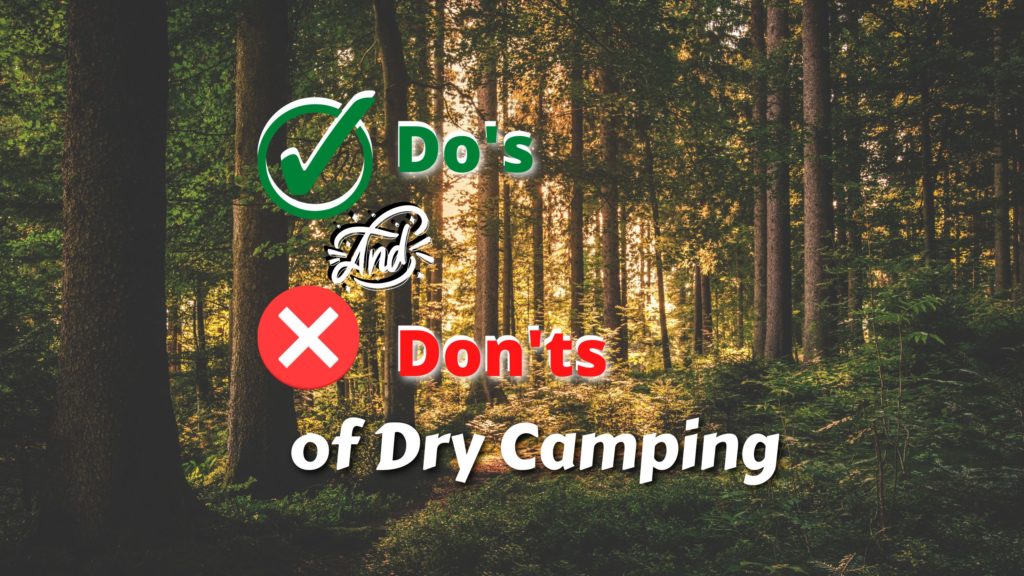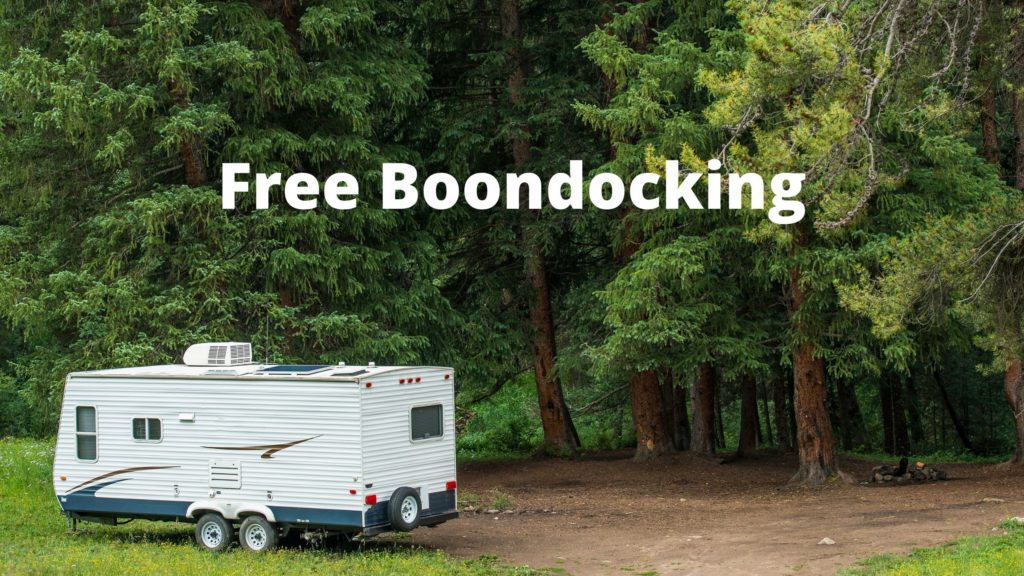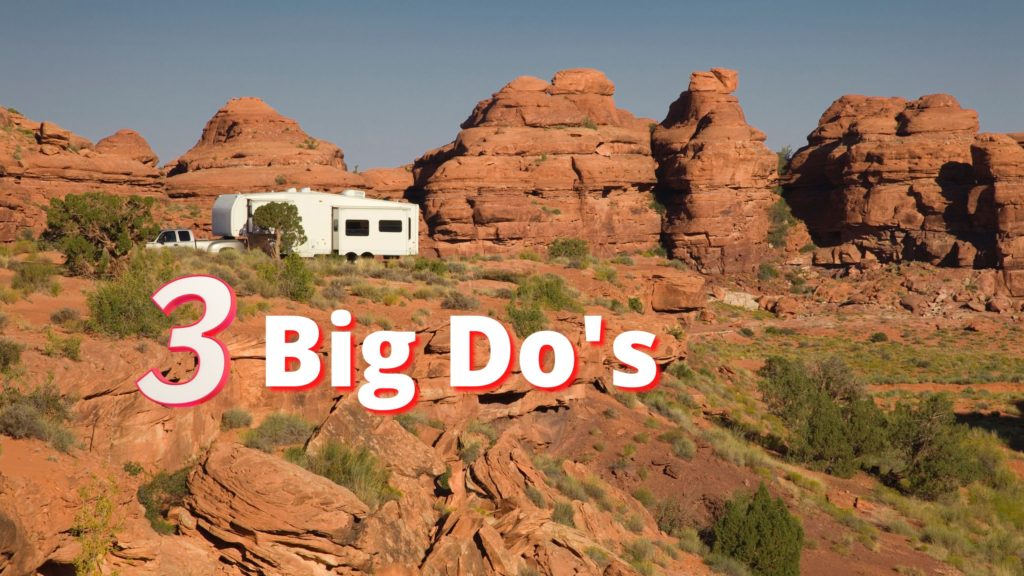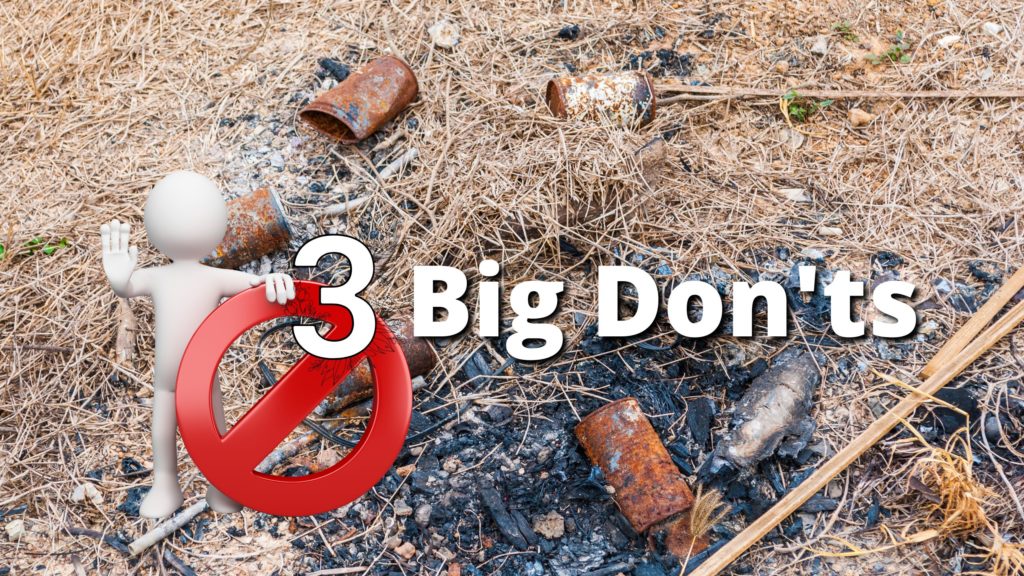Posted by
on
Do you dream of taking your RV, Van, Motorhome, or Trailer off grid to enjoy America’s beautiful National Forests? If so, there are a few things you’ll need to know before heading out for boondocking.
I have three Do’s and three Don’ts that every Boondocker needs to know for to enjoy fun and safe dispersed camping on our public lands.
My goal as a full-time RVer is to camp as remotely as possible where I can mingle with the birds, the trees, and wildlife. I love to explore national forests and BLM (Bureau of Land Management) lands where I can find the absolute best, most remote, and beautiful camping spots. I’ve been doing this since 2016 and I’ve learned a lot. I want to share what I’ve learned so you can get out and enjoy your public lands with confidence.
First, let’s review where you can boondock or dry camp.

We, in the United States, are fortunate to have an abundance of Public Lands. Nearly every state has National Forests and/or Bureau of Land Management (deserts) lands. Most federal public lands allow dispersed camping, which is the official term for Boondocking or dry camping that you’ll see when visiting their websites. Other federal and state agencies that often allow dispersed camping are:
IMPORTANT: You will want to check the area you’re visiting and review their website since every agency has slightly different rules and regulations. Even when visiting BLM lands and National Forests in the same state, different regions can have different rules. So always check before camping.

Generally, you are allowed to stay for 14 consecutive days before you have to move. Remember, there will also be a certain period of time you have to remain gone before returning to the area to camp again. Check the website, stop by the regional office or download a Motor Vehicle Use Map (MVUM) before heading out to make sure you’re obeying all the rules! Now, let’s talk about the three big Do’s when boondocking.

Know what areas are designated for camping and what might be off-limits. Most National Forest district offices have maps (MVUMs) showing what roads are legal for automobiles. This is to help minimize human impact and conserve our public lands for future generations. I like to make sure I’m making the smallest impact on the wilderness. This means I follow the rules. I stay on designated roads and leave no trace. So before you go into any public land for boondocking, check the website or the district office to make sure you know and follow the rules.
Obey all No Trespassing signs. Yes, you will sometimes see these signs within public lands. Private property may have been established and grandfathered in before the area became public lands. Respect those signs and respect people’s private property. You don’t want to get a knock on the door in the middle of the night, or worse, get intimidated by locals who might be mad about you being on their land.
Leave NO trace and pack out what you pack in. That means taking all your garbage with you. Do not leave your garbage behind, and that includes gray water. Don’t leave your mess for somebody else to clean up. Leave only footprints/tire tracks behind. Don’t drive over vegetation, cut down trees, or brush or dig ditches to level out your vehicle. . Don’t feed the wildlife!!! Do not throw food scraps outside. It attracts bears (and a fed bear is a dead bear) and it makes wildlife reliant on humans for food. If it isn’t found naturally in the environment, don’t leave it in the wilderness.

DO NOT block dirt roads with your RV. You might be driving around in the wilderness, as I’ve done, for miles and haven’t seen another person for hours and you can’t find a place to camp. You finally settle on blocking a tiny little dirt road that looks like it hasn’t been used in 15 years. But I promise you, inevitably somebody is going to come along and need to get by. Instead, pull off on the side of the road. Be parked out of the way, so anyone wanting to get by on that road can get by. TIP: Try to get to a spot early enough in the day so you aren’t so exhausted you make an unsafe choice on where you camp. When we are tired, we aren’t thinking clearly. I’ve learned this the hard way.
DO NOT dump your gray water! Your RV holds at least 20 to 30 gallons of wastewater. It’s not natural to the environment. It may not cause catastrophic harm but it is changing the ecosystem. So no, you cannot dump your gray water even if you use natural soaps. Dr. Bronner’s peppermint soap isn’t natural to any forest ecosystem, so leave it in your tank.
DO NOT rely on a cellphone signal for navigation. Oftentimes, you may start with a really strong cell signal, and then suddenly it can drop off. If staying in touch is a concern for you, I recommend getting a personal location device. I have a SPOT. I can push a button and it notifies search-and-rescue or my emergency contact with a GPS coordinate. So if personal safety is a concern for you, consider a personal locator.
You might always want to have a paper map with you. You can’t always rely on your cell phone to navigate out or into a place without a cell signal, so it’s a good idea to have a backup. Whether that’s downloading maps on your computer or phone before you go exploring so that you can have them offline when you need them.
Another option is to have a device that will allow you to have WiFi no matter where you go. Check out my video below on getting Starlink.
I hope these tips help you get out and enjoy boondocking. Remember to have fun, explore, be adventurous, and respect the land. Go out and have a great time living close to nature, and enjoy the sounds, sights, and smells. For me, that’s what boondocking and dry camping in an RV is all about.
Until next time, Be Happy, Be Free, and Be Kind!
Other helpful links for RV Living:
Should you live in a Van or RV?
How to Drive an RV on Washboard Roads
Stealth Camping near Denver & Unique Camping Spot Finder!
DISCLAIMER: Carolyn’s RV Life and Carolyn Higgins share her experiences, thoughts, opinions and ideas in this blog post and on this website for entertainment purposes only. It is not intended to be a substitute for professional advice, instruction or guidance. Viewers/Readers should consult with professionals before pursing any actions or behaviors exhibited in this video. Carolyn’s RV Life or Carolyn Higgins cannot be held liable in the event of any accident or injury that may occur as a result of application of procedures and information provided in this video.
Join the Fun! Subscribe to Carolyn’s RV Life email list and get stories, pictures, videos, advice, tips, and more!
Want to receive sneak peaks, insider news and exclusive content? Join the Carolyn’s RV Life Patreon Community!
2 Responses
Love the info! I’m just starting to looking into going full time as soon as I can retire and I have learned a lot since I started investigating. What I have not been able to find anywhere is what size tanks are needed for Boondocking for two weeks? I have seen limited info on fresh water needs per day but nothing for black and grey. I realize it completely depends on water usage/conservation. It will be me and my dog and I intend to use good water conservation habits. Any guidance would be greatly appreciated. My #1 and 2 criteria for buying an RV is adequate tank size and cargo carrying capacity…but without a good reference point it’s hard to know sufficient vs overkill. I had no idea there was such variability.
Great tips!
How did you know I bought a gallon of Dr. Bronner’s peppermint soap for travel??? That stuff replaces about a dozen bottles that I would normally take.